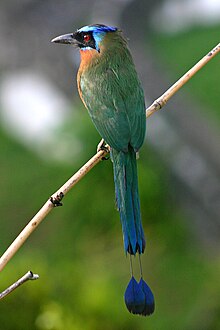| Trinidad motmot | |
|---|---|

| |
| Scientific classification | |
| Domain: | Eukaryota |
| Kingdom: | Animalia |
| Phylum: | Chordata |
| Class: | Aves |
| Order: | Coraciiformes |
| Family: | Momotidae |
| Genus: | Momotus |
| Species: | M. bahamensis
|
| Binomial name | |
| Momotus bahamensis (Swainson, 1838)
| |

| |
The Trinidad motmot (Momotus bahamensis) is a colourful near-passerine bird endemic to the forests and woodlands of Trinidad and Tobago. It is a nonmigratory member of the Momotidae family and the Momotus genus. This species and the blue-capped motmot, Lesson's motmot, whooping motmot, Amazonian motmot, and Andean motmot were all considered conspecific. Though found on both islands, this bird is more abundant in Tobago than it is in Trinidad.
These birds are characterised by their colourful plumage, heavy bills, and owl-like “hoot” call. Their underparts are a deep, rufous colour, with a slightly paler breast and an olive-green wash. The black eyemask and blue-black racquet tails are also distinguishable features for this species. The call is a low owl-like "hoot."[2]
These birds often sit still, and in their dense forest habitat can be difficult to see, despite their size. They eat small prey such as amphibians, small mammals, insects, spiders, earthworms, lizards, small snakes and fledgling birds, and will also regularly take fruit.[2] They are known to eat small tree snails, and to use forest floor rocks as 'anvils' to crack open the hard shells of these prey items to access the soft edible bodies within. They are suspected to strike other prey on the forest floor to stun or kill it as well, and this practice may make it easier to feed to young birds.[3]
Although little information is known about this species, the population is thought to be stable, and is considered least concern by the International Union for Conservation of Nature (IUCN). Despite its small range and unquantified population size, the Trinidad motmot is not believed to approach the thresholds for a vulnerable species under the range and population size criteria. There are no current conservation actions undertaken to protect this species.[4]
The bird is shown on the front of the $5 bank note of Trinidad and Tobago.
- ^ BirdLife International (2016). "Momotus bahamensis". IUCN Red List of Threatened Species. 2016: e.T61634940A95173793. doi:10.2305/IUCN.UK.2016-3.RLTS.T61634940A95173793.en. Retrieved 7 October 2023.
- ^ a b Schulenberg, Thomas S. (2020). "Trinidad Motmot (Momotus bahamensis), version 1.0". Birds of the World. doi:10.2173/bow.trimot1.01species_shared.bow.project_name (inactive 1 November 2024). ISSN 2771-3105.
{{cite journal}}: CS1 maint: DOI inactive as of November 2024 (link) - ^ Rutherford, Mike G.; Bianco, Giovanni (2014-12-31). "Utilisation of Anvils by the Trinidad Motmot (Momotus bahamensis) in Tobago, Trinidad and Tobago". Living World, Journal of the Trinidad and Tobago Field Naturalists' Club: 30–34. ISSN 1029-3299.
- ^ BirdLife International (1 October 2016). "Trinidad motmot". IUCN Red List.
